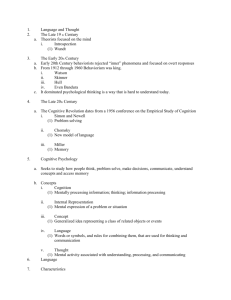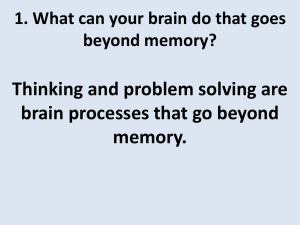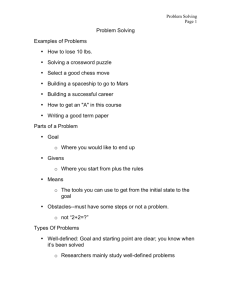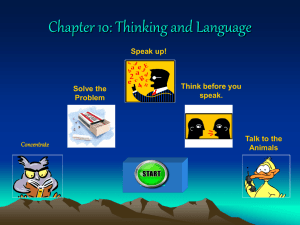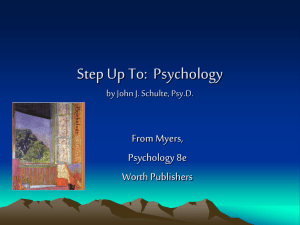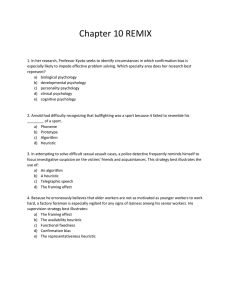Cognition Practice Test: Chapter 10
advertisement
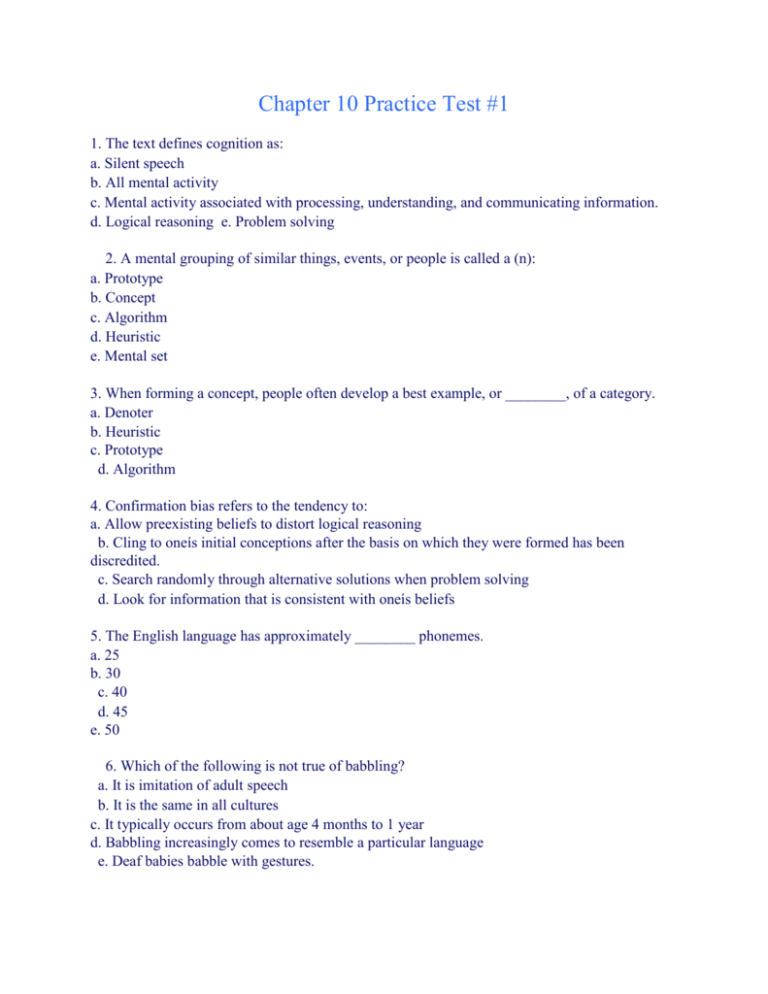
Chapter 10 Practice Test #1 1. The text defines cognition as: a. Silent speech b. All mental activity c. Mental activity associated with processing, understanding, and communicating information. d. Logical reasoning e. Problem solving 2. A mental grouping of similar things, events, or people is called a (n): a. Prototype b. Concept c. Algorithm d. Heuristic e. Mental set 3. When forming a concept, people often develop a best example, or ________, of a category. a. Denoter b. Heuristic c. Prototype d. Algorithm 4. Confirmation bias refers to the tendency to: a. Allow preexisting beliefs to distort logical reasoning b. Cling to oneís initial conceptions after the basis on which they were formed has been discredited. c. Search randomly through alternative solutions when problem solving d. Look for information that is consistent with oneís beliefs 5. The English language has approximately ________ phonemes. a. 25 b. 30 c. 40 d. 45 e. 50 6. Which of the following is not true of babbling? a. It is imitation of adult speech b. It is the same in all cultures c. It typically occurs from about age 4 months to 1 year d. Babbling increasingly comes to resemble a particular language e. Deaf babies babble with gestures. 7. Mental set and functional fixedness are two types of: a. Algorithms b. Heuristics c. Fixation d. Insight 8. Which of the following has been argued by critics of ape language research? a. Ape language is merely imitation of the trainerís behavior b. There is little evidence that apes can equal even a 3-year-oldís ability to order words with proper syntax. c. By seeing what they wish to see, trainers attribute greater linguistic ability to ape than actually exists d. All of the above have been argued. 9. Whorfís linguistic relativity hypothesis states that: a. Language is primarily a learned ability b. Language is partially an innate ability c. The size of a personís vocabulary reflects his or her intelligence d. Our language shapes our thinking 10. Which of the following best describes Chomskyís view of language development? a. Language is an entirely learned ability b. Language is an innate ability c. Humans have a biological predisposition to acquire language d. There are no cultural influences on the development of language | 11. Failing to solve a problem that requires using an object in an unusual way illustrates the phenomenon of: a. Mental set b. Functional fixedness c. Framing d. Belief perseverance e. Overconfidence 12. Which of the following is an example of the use of heuristics? a. Trying every possible letter ordering when unscrambling a word. b. Considering each possible move when playing chess c. Using the formula ìarea=length x widthî to find the area of a rectangle d. Playing chess using a defensive strategy that has often been successful for you 13. The chimpanzee Sultan used a short stick to pull a longer stick that was out of reach into his cage. He then used the longer stick to reach a piece of fruit. Researchers hypothesized that Sultanís discovery of the solution to his problem was the result of: a. Trail and error b. Heuristics c. Functional fixedness d. Mental set e. Insight 14. You hear that one of the Smith children is an outstanding Little League player and immediately conclude itís their one son rather than any of their four daughters. You reached your quite possibly erroneous conclusion as the result of: a. The confirmation bias b. The availability heuristic c. The representative heuristic d. Belief perseverance 15. Because of their lightning speed, computers can retrieve and manipulate stored data faster than people can, but the human brain beats the computer hands down when it comes to: a. Using heuristics b. Following algorithms c. Serial processing d. Simultaneous processing 16. Deaf children who are not exposed to sign language until they are teenagers: a. Are unable to master the basic words of sign language. b. Learn the basic words but not how to order them c. Are unable to master either the basic words or syntax of sign language d. Never become as fluent as those who learned to sign at a younger age. 17. According to the text, language acquisition is best described as: a. The result of conditioning and reinforcement b. A biological process of maturation c. An interaction between biology and experience d. A mystery of which researchers have no real understanding 18. Biologist Karl von Frisch won the Nobel Prize for his discovery that honeybees communicate with each other by: a. Varying the acoustic pitch of their buzzing noises. b. Secreting chemical odors called pheromones c. Performing an intricate dance d. Leading other worker bees on lengthy flights to find nectar 19. The linguistic relativity hypothesis is challenged by the finding that: a. Chimps can learn to communicate spontaneously by using sign language b. People with no word for a certain color can still perceive that color accurately c. The Eskimo language contains a number of words for snow, whereas English has only one. d. Infantsí babbling contains many phonemes that do not occur in their own language and that they therefore cannot have heard. 20. Several studies have indicated that the generic pronoun ìheî: a. Tends for children and adults alike to trigger images of both males and females. b. Tends for adults to trigger images of both males and females, but for children to trigger images of males c. Tends for both children and adults to trigger images of males but not females d. For both children and adults triggers images of females about one-fourth of the time it is used. 21. Researchers who are convinced that animals can think point to evidence that: a. Monkeys demonstrate the ability to ìcountî by learning to touch pictures of objects in ascending numerical order b. Chimpanzees regularly use branches, stones, and other objects as tools in their natural habitats c. Chimps invent grooming and courtship customs and pass them on to their peers d. All of the above occur. ANSWERS 1. C 2. B 3. C 4. D 5. C 6. A 7. C 8. D 9. D 10. C 11. B 12. D 13. E 14. C 15. D 16. D 17. C 18. C 19. B 20. C 21. D
